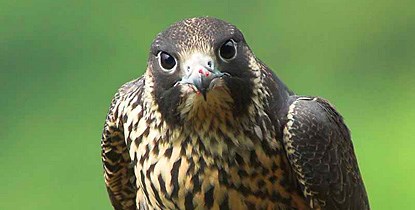
Photo by Gary Hartley The Peregrine Falcon has the most extensive distribution of any bird in the world. The American peregrine falcon is found in Canyonlands, typically nesting in shallow caves high on cliff walls along the Colorado and Green rivers. Their diet consists almost exclusively of birds, and the sound created as they attack their prey can be startling. In a dive, peregrines may attain speeds exceeding 200 miles an hour, making them without a doubt the fastest bird. From 1940 through the early 1970s, the use of DDT as a pesticide caused a precipitous decline in the peregrine population. This chemical agent caused eggshell thinning and breakage, and in some areas successful reproduction stopped altogether. The peregrine was listed as a federally endangered species in 1973. Restrictions on DDT pesticides and coordinated recovery efforts have led to a remarkable comeback. From a low of about 324 nesting pairs in the U.S. and Canada in 1975, roughly 1,650 nesting pairs were counted in 1999. In 1999, the American peregrine falcon was removed from the endangered species list, though the species is not fully recovered throughout its range; rather, it is “no longer threatened with extinction in the foreseeable future.” Peregrines are still on the state endangered species list in Utah, but the species is fairly common in the canyons of southeast Utah. In 1989, the National Park Service began a three-year program to determine peregrine populations in western parks. Canyonlands was part of this program, and initial surveys found five breeding pairs. Canyonlands continues to monitor selected nest sites today, and the local population appears healthy. |
Last updated: February 24, 2015
